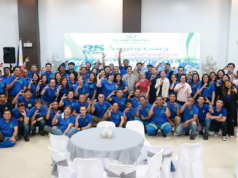DONE DEAL. So we wote of Mabalacat’s cityhood soon as the ink dried on the earliest sangguniang bayan resolutions on its germination.
Done deal. So we wrote again when 1st District Rep. Carmelo “Tarzan” Lazatin made the Mabalacat cityhood his own crusade.
Done deal. So we wrote when the Department of Finance and the Department of the Interior and Local Government certified the local government of Mabalacat having what it takes to be a city, in income, in population and area.
Done deal. So we wrote despite the opposition put up by the Tarlac local government units on the ground of its long-simmering boundary dispute with Mabalacat over the quarry sites.
Done deal. So we wrote – heartened that “this nation can be great again” – when Sen. Ferdinand “Bongbong” Marcos, chair of the local government committee, expressed confidence Mabalacat’s cityhood will pass the bicameral committee, and subsequently the plenary.
Done deal. Indeed, with President Aquino signing on May 15, 2012, Republic Act 10164 declaring 300-year-old Mabalacat as Pampanga’s third city.
Done deal. No other way to go but YES in the July 21 plebiscite on Mabalacat City.
We’ve written all these, having seen it all in the cityhood of San Fernando. Here’s what we came out with in Sun-Star Pampanga, the day the Fernandinos birthed their city, February 3, 2001.
Cityhood: Winning and whining
TODAY Fernandinos will vote a resounding “Yes!” to cityhood.
The outcome is beyond doubt. Unless a miracle greater than EDSA Dos will come to be.
But then again, miracles of that magnitude happen only every 15 years in this country. So there we have with us born today the City of San Fernando.
The arguments have always been heavily in favor of cityhood: from the sublime – “more jobs, more investments,” to the incredulous – “Yes to cityhood, Yes to a flood-free San Fernando.” All feed on the people’s hopes, play with their dreams, tug at their emotions.
The pith of the oppositors’ contention of cityhood automatically resulting to soaring taxes has been easily and definitively demolished by the five-year tax moratorium and the 10 percent ceiling thereafter.
Even at the gut level the “No” position never had a chance. Ask the barrio folk the essential question: “Ano ang gustong itawag sa inyo: probinsiyano o city boy/city girl?”
I will bet my last money that the preference will be for the latter. Our cultural fixity appending backwardness or baduy to the promdi and “class” or sophistication to the city denizen.
Our petit-bourgeois pretension to the sosyal status inhering in our system, no matter our economic state. So, how can the cityhood proponents fail?
Thoughts of class and social status bring to mind a very disturbing facet in the cityhood debates. There is a common denominator – unanimity even – among the protagonists and antagonists. That is in class origin.
Traders and merchants, bankers and builders, leaders of the local business chamber, Rotarians, Jaycees and other uppity groups – the moneyed and the propertied monopolized all the cityhood discussions, turning the activity into an intramural among the local elite, be they Old Money or nouveau riche.
Hence, the emphasis on investments, on economic concerns – the common ground where the divergent interests of both pro- and anti-cityhood groups found confluence.
So where did that leave the greater mass of the people of San Fernando?
We know that through barrio dialogs both sides spoke to them. But who spoke for them?
I failed to hear even but a whimper from the urban poor, militant labor, committed peasant.
So were their thoughts irrelevant and immaterial to the issue at hand? Were they no more than a herd of cattle to be led by the nose to the polling booth on cityhood?
If such were the case, then this was a clear exercise in class stratification. An instance of pure elitism – the domination of the majority by a self-chosen few. Or am I exaggeratedly high-planing a plain political exercise?
(Don’t ask me how I voted. I did not. I am not a registered voter in San Fernando.)
It is all moot and academic now, as my favorite Attorney Agaton is wont to say.
Mayor Rey Aquino and his cohorts among the local aristocracy have their city.
The people can only hope and pray that all their promises of progress and prosperity attendant to cityhood will not fade faster than the streamers and stickers they were printed on.
The cityhood campaign unduly raised the people’s expectations with the recurring refrain of cityhood as cure-all elixir to San Fernando’s ills – from flooding to silting, from bad roads to traffic, from squatters to crime, from garbage to whatever.
Just about the only problem cityhood won’t solved is jueteng. But then again that is no problem. It is an opportunity. Isn’t that so Senor Alaska?
The people will hold Aquino and his aristocratic circle accountable for this. They better deliver. Morphing the municipality of San Fernando into a city is rather easy. Altogether different is running the city.
I wish you all the luck.
q q q
So it was with San Fernando. So it shall not be with Mabalacat. There is no clear aristocracy here. There is but Boking, pa rin! And that makes all the difference.




